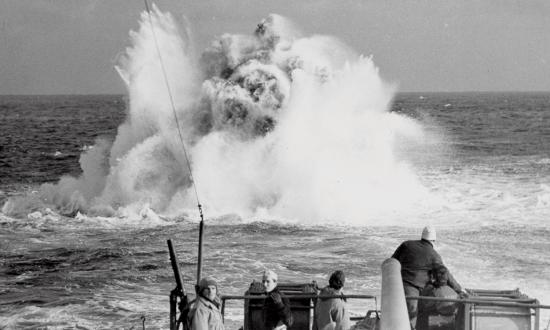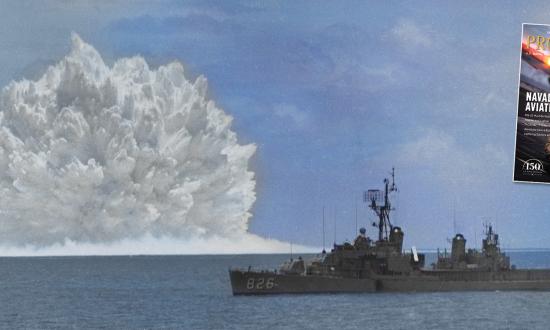Logistics 2030: Foraging Is Not Going to Cut It
Unmanned Vessels for EABO
I found myself wholeheartedly agreeing with Lieutenant Colonel Donlon. I was also pleasantly surprised when I saw that he referenced one of my articles previously published in Proceedings. It seems we both agree with the adage that “amateurs talk strategy; professionals talk logistics.”
Unfortunately, the Marine Corps as a whole is falling short in the logistics capabilities and capacity necessary to make expeditionary advanced base operations (EABO) a reality.
Consider the board game the Expeditionary Warfare School uses to help teach tactical decision-making. All iterations of the game start with a presumption that either the Marine littoral regiment is already in position or that air or surface connectors will be able to transport stand-in forces past enemy aircraft and surface ships without issue.
To make such an assumption in the face of real enemy ships and aircraft with real antiship and antiair missiles would be suicidal. Further, there is little consideration given to resupplying or moving stand-in forces after they have occupied their initial positions. Once their antiair and antiship munitions have been expended, they simply sit on their respective islands and hope the Navy can win the fight—or wait to be destroyed.
Of course, Lieutenant Colonel Donlon goes beyond identifying serious logistical problems for the Marine Corps. He also explores many potential solutions. From prepositioning as much as possible as far forward as possible to discussing different platforms that can move the supplies to the EABs that need them, Lieutenant Colonel Donlon provides a well-rounded view of multiple possibilities that could help the Marine Corps move forward.
Marines at every level would be wise to ponder this article. Doing so might spark more ideas on how to solve the logistical needs of EABO.
—Capt Karl Flynn, USMC
'A Collision Did Not Occur': An Early Lesson in Leadership
Rear Admiral Bitoff’s account of Rear Admiral Eugene Fluckey’s direction not to report a minor collision was timely and a prudent lesson to the modern Navy.
In my civilian life, I am a senior pilot in a major East Coast port. In my business, we conduct thousands of close-quarters shiphandling evolutions during a career. It is understood that over the course of that career collisions, allisions, and groundings are not a matter of if, but when.
The business of driving large ships in close proximity to other ships, static objects, and shallow bottoms is inherently high risk, and it is the commercial harbor pilots’ responsibility to mitigate it through training and experience. Even so, our job is to accept that risk and its inherent consequences—because sometimes, the most prudent mitigation is not enough.
The mindset of military shiphandlers should be no different. A professional culture that does not understand that shiphandling can be a contact sport some days is not realistic, and it lacks the sense true mariners possess.
Combatant leaders must be of the type that are willing to accept risk with the understanding that accidents will occur, even with the best efforts. Punishing those who take risks and fail while promoting those who are afraid to accept calculated risk is a recipe for a far worse outcome than a minor collision, allision, or grounding.
—LT John R. Kinlein, USNR, Strategic Sealift Officer Harbor Pilot
Upgun Cutters to Meet Today's Naval Threats
Major Surface Assets of the U.S. Coast Guard
When I enlisted in the Coast Guard, our ships had hedgehog antisubmarine weapons, three torpedo tubes port and starboard, and 5-inch 38-caliber naval guns, as well as sonar and rated sonarmen. During my time, some cutters were even upgunned with surface-to-surface rockets.
The surface asset list shows weapon systems on today’s cutters ranging from the Mk 110 57-mm (Bofors) gun, to 20-mm Phalanx close-in weapon systems, to M2 .50-caliber and M240B 7.62-mm machine guns.
With the Coast Guard performing freedom of navigation operations and deploying forward in the Pacific and elsewhere, isn’t it time to upgun these major assets rather than waiting until hostilities commence? Otherwise, if they survive, they will have to be pulled out of the fight for installation of proper offensive/defensive weapons.
At a minimum, larger cutters need sonar and appropriate antisubmarine weapons—or shall we have to relearn the lessons of World War II the hard way to be capable of performing coastal patrol, convoy escort, and offensive hunt-and-kill missions?
Now is the time to do the upgunning, while shipyards are available, necessary training of personnel can take place, and weapon inventories remain available. If we do not do so now, we might sadly find ourselves reviving the old saying: ‘You have to go out. You don’t have to come back!’
—CAPT John J. Marks, USCGR (Ret.)
Additive Manufacturing Needs a Champion
I heartily agree with the authors that additive manufacturing technology promises to revolutionize many aspects of production, maintenance, and repair for the Navy and Marine Corps. But I would recommend a different model for a champion than Hyman G. Rickover: Rear Admiral William Francis Raborn Jr. He led a team that, with strong congressional, academic, and Department of Defense support, produced the Polaris missile system.
It is results that count, of course, but leadership style is important, too. Compared with Admiral Rickover, it was said about Admiral Raborn: “You don’t have to be an S.O.B.!”
—Brent Cottingham
Grow the Coast Guard–Sea Cadet Partnership
Former Sea Cadet Chief Petty Officer Illarionov’s article was spot on—and it could apply to the Navy as well. It was a joy to read how now-retired Coast Guard LCDR Jeremy Rodriguez’s successful military and civilian careers were shaped by his Sea Cadet experiences working alongside Coast Guardsmen underway on board the USCGC Munro (WHEC-724) The article was interesting to me, in particular, because I had a small part in arranging Jeremy’s cruise that summer.
Then as now, Navy and Coast Guard commanding officers have a fantastic opportunity to invest in the future of our naval services. OpNav 5760.2F and the Coast Guard’s ComdInst M5700.13 provide a starting point for future leaders interested in having life-changing experiences as Sea Cadets.
—LCDR Joseph T. Martin, USN (Ret.), and Regional Director—Bremerton/Olympic Peninsula & Southwestern Washington
U.S. Naval Sea Cadet Corps
Politics: Stay Professional, But Don’t Stay Silent
No discussion of politics? Some politicians have made that tradition a challenge in a world in which everything is politicized. Vaccinations used to be the realm of physicians and immunologists. Rules concerning control of classified material were straightforward. The commander-in-chief respected the military, and the military returned that respect.
Senior officers should be in quiet discussion about the meaning of “lawful order” and possible conflicts between the oath to the Constitution and their duty to obey a superior’s order. When a commander-in-chief bullies, belittles, insults, and threatens those senior officers out of spite, petulance, disdain, or ignorance, it is a challenge to give him the respect the office is entitled to, particularly when he ignores rules, laws, and the Constitution whenever they conflict with his whims and desires.
When a single U.S. Senator blocks promotions of flag and general officers because of a political issue unrelated to national defense—compromising readiness—the “no politics” policy stretches thin. Modifiers for those officers waiting for confirmation such as “acting” and “performing the duties of” signal that the country’s defense is on “hold.” We wait, listening to the elevator music, wondering what adversaries are doing.
Because we dare to read, think, speak, and write about what affects national security, the dare should include politics when the politics are contrary to our oaths and our honor.
—CDR Earl J. Higgins, USN (Ret.)
Taiwan Strait: The Ocean’s Most Contested Place
Captain Walsh’s article was a good overview of the Taiwan Strait and its economic value to both Taiwan and China. Things have certainly changed in how the United States perceives the Strait.
In the 1960s the antisubmarine patrol squadron deployed to Iwakuni, Japan, maintained a small detachment at Tainan on Taiwan’s west coast from which surveillance flights were carried out routinely. That’s not to say some of the flights were not a little exciting, but they were flown nevertheless.
—CAPT William G. Klett, USN (Ret.)
Mandate Uninterrupted Rest Hours for a Safer Navy
Petty Officer Woolsey makes some valid points in his article regarding the persistent issue of sleep deprivation in the seagoing Navy today. But the amount of sleep a deployed sailor gets every day depends significantly on the rate and whether he or she stands underway watches. Bridge, combat information center (CIC), and engineering watchstanders all have their sleep affected by the nature of the at-sea schedule. The rest of the crew routinely works an 0800–1600 daily schedule. These crew members—from personnel and supply, for example—can usually count on a full eight hours’ sleep
every night.
The 2017 collisions between the two Navy destroyers and commercial vessels can be attributed to inadequate manning and degraded communication between the warships’ bridges and CIC, not sleep deprivation. If the CICs had been doing the job expected of them in reporting all surface contacts and making course recommendations to avoid collisions to an alert bridge watch, both incidents could have been avoided.
I have previously recommended the formation of a “flying squad” of enough personnel to conduct daily cleaning and maintenance to support messing and berthing inspections and planned maintenance requirements. The underway watchstanders could then be freed to stand port-and-starboard/12-on, 12-off watches. This is how the USS Reeves (CG-24) functioned when I served on board, and it worked.
Of course, as the saying goes, “The best-laid plans of mice and men”—all this exact underway watch planning will go by the wayside when and if the Navy finds itself at war and facing imminent combat, as evidenced by the events unfolding in the eastern Mediterranean. Then the lookouts on the bridge and the watchstanders in CIC and engineers in Main Control are going to
have to “do more with less and not screw up!”
—OSC (SW/AW) John M. Duffy, USN (Ret.)
Bring the Naval War College Into the Future
(See M. Wright, pp. 20–24, September 2023; T. Clarity, pp. 98–100, October 2023; and D. Winkler, p. 95, November 2023)
While Commander Wright makes some persuasive arguments in favor of remote learning, if there is a lesson to be taken from the COVID-19 pandemic, it is that remote learning is a poor substitute for in-person education. Not only because of limited interactions between students and teachers, but also because of inevitable internet connectivity disruptions, distractions for the remote learner, and—as Commander Wright acknowledges—the lack of face-to-face interactions between students and faculty inside and outside the classroom. This was true in public schools during the pandemic, and it will also be true at the Naval War College. At the height of the pandemic, remote learning made perfect sense. But, as things have improved, it should be used only for students for whom the in-person option is impossible.
Commander Wright also mentions one downside of Newport, Rhode Island: It is not a “fleet concentration” area. That has not always been the case. Until 1973, Newport served as headquarters for Cruiser-Destroyer Force, Atlantic, with more than 30 homeported ships, but the Nixon administration moved all active ships to southern ports, leaving none ported north of Norfolk, Virginia. The Newport piers and waterside facilities still exist. An analysis by the 1993 Base Realignment and Closure Commission estimated that Newport could berth at least 19 cruiser-equivalent ships.
Newport should again be a fleet concentration area with a squadron of surface ships. This would do more than just reestablish a surface naval presence in the Northeast. Such permanent surface ship presence would provide synergies with the Naval Undersea Warfare Center and opportunities for antisubmarine warfare training with submarines from the submarine base in nearby New London, Connecticut.
In addition, when not deployed, these ships could serve as school ships for the Surface Warfare Officers School Command as well as Naval War College students more generally. NWC students prospectively assigned to these ships could stay an entire year, without the need for a short-term relocation and the resulting family disruptions.
Finally, contrary to what Commander Wright says, for most of the year, Newport is not “frigid.” It is a great place to visit and to live, and, regarding the few months when it is colder in Newport, remember that the Navy has to operate in any climate, not just the tropics.
—Brandon Kampe
Asked & Answered
Although Clint Eastwood remains one of my favorite actors, his Heartbreak Ridge character’s deliberate execution of helpless wounded Cuban soldiers certainly disqualifies that character from being honored for doing “the best job portraying a U.S. Marine,” regardless of his other heroics. It is against international law, Marine Corps policy, good small-unit leadership, and Western tradition to abuse prisoners.
A possibly apocryphal story says that the then–Commandant was given a personal, prerelease screening of the film. On viewing this obvious war crime, he supposedly secured the showing at once and that same evening fired the responsible Marine Corps Hollywood liaison officer who had reviewed the script before production and approved it for service cooperation.
—LtCol Robert B. Lange, USMC (Ret.)
Naval Comms
I was quite surprised by the apparent omission of flashing light communications in Mr. Clift’s otherwise excellent review of naval communications.
During the 1960s, my antisubmarine destroyer would periodically train in various emission-control conditions. Flashing lights were one of our primary means of communicating during them.
Over the past 20-plus years, flashing light communication has largely been eliminated, but it is my understanding that the powers that be are actively discussing its return. That would be an extremely wise decision given the vulnerability of most other systems to interference or denial.
—Guy J. Agrati
Designing a Force with a Fighting Foot Ashore
The caption on page 47 says Henderson Field was taken in 1941, but the year was 1942.
On page 48, I believe the Marine going over the top is First Lieutenant Baldomero Lopez, a member of the U.S. Naval Academy Class of 1948 and a Medal of Honor recipient. His room in Bancroft Hall was in our company area, and I remember reading the plaque outside the door 60-odd years ago.
—LCDR James B. Craven III, USNR (Ret.)








